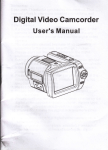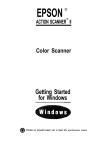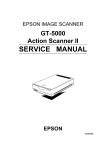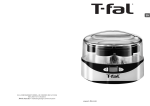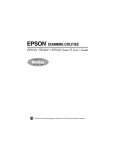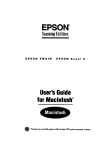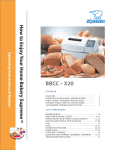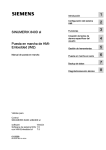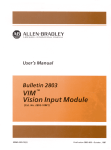Download Epson ActionScanner II Mac - ActionScanning System II User`s guide
Transcript
EPSON ACTIONSCANNER™II Getting Started for Macintosh @ printed on recycled paper with at least 10% post-consumer content A Note Concerning Responsible Use of Copyrighted Materials Like photocopiers, scanners can be misused by improper copying of copyrighted material. Although Section 107 of the U.S. Copyright Act of 1976 (Title 17, United States Code), the “fair use” doctrine, permits limited copying in certain circumstances, those circumstances may not be as broad as some people assume. Unless you have the advice of a knowledgeable attorney, be responsible and respectful by not scanning published material without the permission of the copyright holder. Copyright Notice All rights reserved. No part of this publication may be reproduced, stored in a retrieval system, or transmitted in any form or by any means, electronic, mechanical, photocopying. recording, or otherwise, without the prior written permission of Seiko Epson Corporation. No patent liability is assumed with respect to the use of the information contained herein. Neither is any liability assumed for damages resulting from the use of the information contained herein. Neither Seiko Epson Corporation nor its affiliates shall be liable to the purchaser of this product or third parties for damages, losses, costs, or expenses incurred by purchaser or third parties as a result of: accident, misuse, or abuse of this product or unauthorized modifications, repairs, or alterations to this product. Seiko Epson Corporation and its affiliates shall not be liable against any damages or problems arising from the use of any options or any consumable products other than those designated as Original EPSON Products or EPSON Approved products by Seiko Epson Corporation. ActionScanning is a trademark of Epson America, Inc. EPSON is a registered trademark of Seiko Epson Corporation. General notice: Other product names used herein are for identification purposes only and may be trademarks of their respective companies. EPSON disclaims any and all rights in those mark. Copyright 0 1995 by Epson America, Inc. Torrance, California, USA 12/95 Contents Introduction . . . . . . . . . . . . . . . . . . . . . . . . . . . 1 . . . . . . . . . . . . . 2 Setting Up the Scanner . . . . . . . . . . . . . . . . . . . . . 2 Connecting the Scanner to Your Macintosh . . . . . . . . . 4 Installing the EPSON Scanning Utilities . . . . . . . . . . . 6 . . . . . . . . . . . . . . . . 8 . . . . . . . . . . . . . 9 . . . . . . . . . . . . . . . . . . . . . . . . 9 System and Memory Requirements Installing Adobe PhotoDeluxe Installing Maxsoft-Ocron Wordlinx Scanning Images Putting It Together . . . . . . . . . . . . . . . . . . . . . . . Calibrating Your System . . . . . . . . . . . . . . . . . . Selecting the Correct Resolution . . . . . . . . . . . . . 11 12 18 iii Introduction This package contains everything you need for professional quality color scanning: Q EPSON® ActionScanner™ II color scanner, which scans in full color (24 bit) or grayscale monochrome (8 bit) at 300 dpi (dots per inch) Q SCSI system cable CI EPSON Scanning Utilities for Macintosh® (EPSON Scan! II and EPSON TWAIN), which let you capture scanned images, export the images in a variety of formats, calibrate your scanner, and use the scanner’s advanced features with software programs that support the industry standard TWAIN interface P Adobe® PhotoDeluxe,® a powerful, imageediting program (supplied on a CD) that lets you edit color digital images captured with your scanner or a digital camera, or copied to a PhotoCD. Cl Maxsoft-Ocron™ Wordlinx,™ an optical character recognition (OCR) program that lets you scan printed text and convert it into a text file you can edit and format. This booklet tells you how to set up your scanner, install the software, and scan an image. If you need more detailed information after you begin scanning, consult the manuals and online documentation for the ActionScanner II, EPSON Scanning Utilities for Macintosh, PhotoDeluxe, and Wordlinx. 1 System and Memory Requirements For the scanner and your software to work properly, your system must include the following minimum configuration: D Apple® Macintosh or Power Macintosh™ computer with a 68030 or 68040 processor P Apple system software 7.0 or higher Q 8MB of system RAM; 4MB of application RAM Note: 8MB is the minimum amount of RAM; graphics applications run faster and more efficiently with at least 12MB of RAM. 0 At least 100MB of free hard disk space for scanner applications and images, depending on the size of the images 0 A color monitor (one with a 24-bit video card is recommended) 4 For PhotoDeluxe, a double-speed or faster CD-ROM drive. Setting Up the Scanner Follow these steps to set up the scanner: 1. Take the scanner out of its box and place it on a flat, stable surface with the rear panel facing you. 2. 2 Remove the tape securing the scanner cover and pull out the paper underneath the cover. 3. Locate the round screw in the middle of the rear panel and turn it counterclockwise. If necessary, use a coin to loosen it. 4. Remove the screw and push it into the storage hole marked STOCK; do not screw it in. 5. Connect one end of the power cable to the power inlet on the rear of the scanner and plug the other end into an appropriately grounded electrical outlet as shown below. If the scanner comes on when you plug it in, turn it off by pressing the OPERATE button. Warning: Whenever you turn off the scanner, wait at least 10 seconds before turning it back on. Rapidly turning it on and off can damage the scanner. Connecting the Scanner to Your Macintosh Follow the steps below to connect the scanner directly to the SCSI port on your Macintosh using the SCSI cable included with the scanner. This cable has a 25-pin connector on one end and a 50-pin connector on the other. The SCSI ID is already set to 2 and the SCSI terminator is on. If you are already using the SCSI port on your computer for another SCSI device, such as an external hard disk, you need a SCSI cable with a 50-pin connector on both ends. You can then connect the scanner to your other SCSI device and set the SCSI ID and terminator as necessary; follow the instructions in Chapter 1 of your scanner User’s Guide. 1. Turn off your Macintosh, scanner, and all peripheral devices. Caution: Be sure that your Macintosh, scanner, and all peripheral devices are turned off before you plug in the SCSI cable. 2. Plug the 25-pin connector into the SCSI port on the Macintosh with a e icon above it. Tighten the two screws on the sides of the connector. 3. Connect the 50-pin end of the cable to either the top or bottom SCSI connector on the scanner; then fasten the connector with the wire clamps on its side. 4. Turn on the scanner by pressing the OPERATE button. The green OPERATE light comes on on the top right side of the scanner. The READY light comes on when the scanner has warmed up. 5. Then turn on your Macintosh. (Always turn on the scanner before turning on the Macintosh.) Installing the EPSON Scanning Utilities The EPSON Scanning Utilities include EPSON Scan! II and EPSON TWAIN for the Macintosh. Scan! II uses TWAIN to capture images and then saves and exports these images in a variety of file formats. It also calibrates your scanner and output devices to produce images nearly identical to the originals. EPSON TWAIN is a set of drivers designed to access your scanner’s advanced features for any software that supports TWAIN for Macintosh. TWAIN drivers are an industry standard for acquiring image data from a variety of external sources without leaving your application program. Follow these steps to install the EPSON Scanning Utilities: 1. Turn on the scanner. 2. Hold down the Shift key while turning on the Macintosh to turn off any extensions. 3. Insert the EPSON Scanning Utilities Disk 1 in a diskette drive. 4. Double-click the Disk 1 icon on the desktop. 5. Double-click the Installer icon in the Disk 1 folder. 6. 6 After a few moments, you see the initial setup screen. Choose OK to continue. You see the Easy Install screen: Easy install Click Install to place the l It Scanner Utility Program EPSON Scan! II on the hard disk named 63 ZFP 320 I Customize 1 7. If you want to install all the program components, click Install. To select only one or two components, click Customize. Then highlight the components on the next screen and click install. 8. The program begins copying files. Insert the diskettes as prompted. 9. When installation is complete, you see a success message. Click Restart to restart your Macintosh. The program creates an EPSON Scan! II folder on your hard disk containing a Scan! II and Scan! II Help icon. 10. Raise the scanner’s cover and place an image face down on the upper right comer of the glass surface. Then carefully close the cover. 11. To test your software, click the Scan! II icon. 12. From the File menu, select Acquire. 7 You see the EPSON TWAIN easy screen: a F SONTWl3IN 9 v Document Source : [ Flatbed image Type : Color Destination : Screen Photo 7 13. Click Scan. After a moment, you see the image in the Scan! II Image 1 screen. If you do not see it, click Close and repeat all the scanner setup steps, beginning on page 2. 14. Click Close and then exit Scan! II. Installing Adobe PhotoDeluxe If you have a CD-ROM drive, follow these steps to install Adobe PhotoDeluxe: 1. If necessary, hold down the Shift key while turning on the Macintosh to turn off any extensions. 2. Insert Adobe PhotoDeluxe CD in your CD-ROM drive. 3. Double-click the Install Adobe PhotoDeluxe icon. 4. Click Continue. 5. On the next screens, follow the displayed instructions to install the entire program, and click Install. 8 6. When you see an installation completion message, click Quit to exit the Installer. 7. Restart your Macintosh. See the online documentation that comes with PhotoDeluxe for instructions on using the program. Installing Maxsoft-Ocron Wordlinx Follow these steps to install Wordlinx: 1. If necessary, hold down the Shift key while turning on the Macintosh to turn off any extensions. 2. Insert the Wordlinx Program Disk 1 in a diskette drive. 3. Double-click the Installer icon in the Disk 1 folder. 4. You see the initial program screen. Click Install. 5. The program copies the files and when it is finished, displays a success message. Click Quit. The program creates a Wordlinx 2.0 folder. See the Wordlinx documentation for instructions on using Wordlinx. Scanning Images Now you are ready to start scanning. First, choose an image to scan. The best choice is a color photograph. Printed pictures, such as those in magazines, do not scan as well as photographs because of the dot patterns used in the printing process. When selecting an image or text to scan, respect the rights of the copyright holders. Don’t scan published materials without first checking the copyright status. 9 After you choose an image, follow these steps to scan it: 1. Raise the document cover on the scanner and place the image face down on the glass surface. 2. Carefully close the document cover so that you do not disturb the position of the photograph on the glass. 3. Insert the Adobe PhotoDeluxe CD in your CD-ROM drive. 4. Start PhotoDeluxe. 5. Click the Scan Photo button. 6. Select TWAIN-Acquire from the Acquire Module List. 10 You see the EPSON TWAIN easy screen: r:: LPSON TUIRIN Docwnmt Sourer: [ Flatbed I lmaqe Type : COlc4- Photo v Dniination : Screm . 7. Select Scan. TWAIN pre-scans and then scans your image. 8. In a few moments, the scanned image is imported into PhotoDeluxe. If you like, you can now modify the image using any of the PhotoDeluxe features. Putting It Together Once you have scanned images and text, you can put them together in reports, newsletters, brochures, presentations, or a myriad of other formats. Several factors affect how closely your scanned image reflects the original, especially when you print the images on paper. The next sections discuss basic calibration techniques and resolution settings you can use in EPSON Scan! II to help you achieve the results you want. See your EPSON Scanning Utilities User’s Guide for Macintosh for information on other, more sophisticated methods of modifying your scan. Calibrating Your System Calibration allows you to match your scanner and your output device so you can reproduce color images that are very close to the originals. Because monitors use a different method to display color images than printers use to print them, images look different when displayed than when printed. Also, each output device may produce different printed results. For example, an image printed on an electronic color printer looks dramatically different when printed on a printing press. EPSON Scan! II calibrates your scanner with your monitor, application, and printer by analyzing the results of a calibration sample at each stage of the process. The basic calibration process consists of: P Calibrating your monitor to your scanner 0 Enabling screen calibration 0 Exporting a calibration chart to your application 0 Creating calibration profiles for your printer(s) Q Scanning using the calibration profile. These procedures are described in the following sections. 12 Calibrating your monitor to your scanner Follow these steps to calibrate your monitor to your scanner: 1. Select EPSON Scan! II in the EPSON Scan! II folder. 2. Choose Screen Calibration from the Calibrate menu. You see this screen: Screen Calibration Adjust the slider below until the gray areas appear the same. 3. Look at the display from a distance and adjust the slide bar until the separate rows have the same basic color intensity. 4. Choose OK. Enabling screen calibration Now follow these steps to enable screen calibration so EPSON TWAIN can use it when you scan images: 1. From the File menu, choose Acquire to start EPSON TWAIN. 2. Choose Advanced. You see the advanced TWAIN screen. 3. Select Configuration; you see the Configuration dialog box. 13 4. Select the EPSON Calibration radio button to enable screen calibration. 5. Choose OK. 6. Close the EPSON TWAIN screen. Exporting a calibration chart To calibrate your printer to your scanner, you need to export a calibration chart from Scan! II to your application and then create a calibration profile. Note: If you have any of these EPSON Stylus® ink jet printers, Scan! II provides printer calibration profiles for you so you do not have to create them: EPSON Stylus COLOR EPSON Stylus COLOR IIs EPSON Stylus Pro XL EPSON Stylus COLOR II EPSON Stylus Pro See page 17 now for steps on scanning using these profiles. Follow these steps to export a calibration chart: 1. Select Export Calibration Chart from the Calibrate menu. 14 You see the following screen: Export Calibration Chart... This function calibrates your scanner/software/printer system by passing a calibration sample through each stage and analyzing the results. Select a file format you can import into the software you plan to use and click on ‘Export’. Import the resulting Calibration Chart file into your software and print i on your printer. Then return to EPSON Scan!Il and select ‘Create Calibration Profile....’ from the ‘Calibrate’ menu. t3 EPSON Scan!II v Export image as: Untitled - 1 Export File Format: 1 PlCl 7[ (E.ncsl) 2. In the Export File Format pull-down menu, select the PICT file format, if necessary. 3. In the Export image as field, type the name you want to use for the calibration chart file, such as COLOR1. 4. Choose Export to create the calibration chart file in the EPSON Scan! II folder. 5. Exit EPSON Scan! II. 6. Insert the Adobe PhotoDeluxe CD in your CD-ROM drive and start PhotoDeluxe. 7. Open the calibration chart file you exported to the EPSON Scan! II folder. 8. The calibration chart appears in the Photoshop window. It contains nine blocks of color gradations, some grayscale gradations, and a black border on three sides. Save the chart within Photoshop by selecting Save from the File menu. 15 9. Print the calibration chart on your color printer. If you have more than one printer, print the chart on each one. 10. Exit PhotoDeluxe. Creating printer calibration profiles Follow these steps to create a calibration profile for each printer: 1. Start EPSON Scan! II, if necessary. 2. Place the printed calibration chart face down on the glass surface of the scanner. 3. Choose Create Calibration Profile from the Calibrate menu. You see the following screen: Create Calibration Profile... Place the Calibration Chart you printed In the scanner. Make sure it is aligned properly. Enter a file name for the file. lifter you click ‘Continue’, the EPSON TWAIN dialog appears. Make sure it is set for Calibration. Finally, click on the ‘Scan’ button. Filename: Your printer 4. In the Filename field, type the filename of the calibration file you want to create, such as COLOR1 PRINTER. 5. Choose Continue. You see the EPSON TWAIN advanced screen. (If you see the easy screen, select Advanced.) 6. If necessary, select Color Photo from the Image Type pull-down menu. 7. Select Calibration Profile from the Destination pull-down menu. 8. Choose the Scan icon. The program scans the calibration chart and creates a calibration profile. You see the main Scan! II program screen. Now you can use this calibration profile when you scan images. Scanning using calibration Follow these steps to use a calibration profile when you scan: 1. Choose Acquire from the File menu of EPSON Scan! II or choose Scan Photo in PhotoDeluxe. In PhotoDeluxe, then select TWAIN-Acquire also. You see the EPSON TWAIN advanced screen. (If you see the easy screen, select Advanced.) 2. Choose the Destination button; you see the Destination dialog box. 3. If you have one of the EPSON ink jet printers listed in the Note on page 14, select the printer from the Destination Name pull-down menu. The Calibration description is assigned automatically. Go to step 5. If you just created a calibration profile for your printer, type a unique name for the profile, such as Color1 Profile, in the Destination Name field. Go to step 4. 4. From the Calibration pull-down menu, select the description of the printer you used when you scanned the profile (for example, COLOR1 PRINTER). 5. Choose Save. 6. Choose OK. You see the EPSON TWAIN advanced screen. 17 7. Select the Scan button. The scanner scans using the information in the calibration profile to produce the best possible image for your printer. Selecting the Correct Resolution To select the best resolution for scanning an image, you must consider three factors: Q Type of image you are scanning 0 Final output device type CL Acceptable file size. You’ll select different resolutions for scanning line drawings and halftones than for scanning photographs. The final output device is the device on which you plan to ultimately print the image. This may be a printer connected to your computer or a commercial printing press. In addition, the file size of the scanned image may determine the resolution you select. The file size may be very large for high resolution scans, taking up valuable disk space and causing longer processing or printing time. Generally, the higher the resolution you choose, the larger the file. Note that a very high resolution scan may not produce a better-quality printed image because your output device may not recognize the high resolution information stored in the file. In other words, there is no point in scanning at a higher resolution then your output device is capable of. To keep file sizes manageable, select the lowest resolution that provides acceptable quality on your output device. 18 To scan at the optimum resolution for your image and final output device, select your resolution based on the recommendations in the table below. The resolutions are listed in dots per inch (dpi) or pixels per inch (ppi). Recommended resolutions Output device line aft Gray scale Color Monochrome printer 300-600 80-170 - Desktop or office color printer 300-720 150-240 150-240 Printing press or image setter 600-1200 150-350 150-350 You can change resolutions using EPSON TWAIN by choosing the Destination button on the advanced screen. In the Destination dialog box, select the box beneath the resolution type you want to change (Drawing/Halftone or Photo); then choose the resolution for that type from the pull-down menu. For more information on resolution, see your scanner User’s Guide and the EPSON Scanning Utilities User’s Guide for Macintosh. Now that you know the basics, you’re ready to begin scanning. For additional information, see the manuals and online documentation for your scanner, the scanning utilities, PhotoDeluxe, and Wordlinx. 19






















